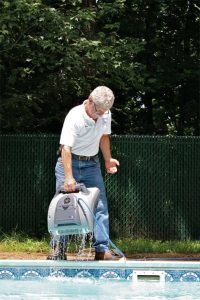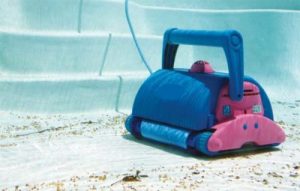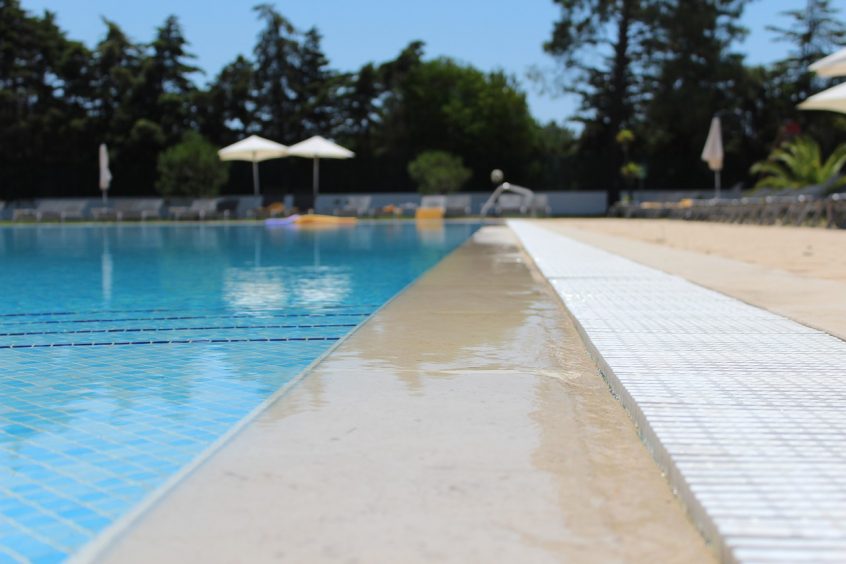Today, automatic and robotic pool cleaners are not only a convenient maintenance accessory for pool owners, but are also a great tool for industry professionals when incorporated into their service routine. That said, with so many of these products in the market, not only do industry professionals need to be well-versed in troubleshooting any number of complications they might face, but also be able to resolve any issues the consumer might have when using their cleaner. In addition to common user error, like any robotic product, sometimes faulty parts can be the cause of a robotic/automatic pool cleaner to malfunction. This article will provide some troubleshooting tips for industry professionals and pool retailers when faced with a pool cleaner that is not working properly.
An easy answer to a common problem
An automatic pool cleaner that constantly flips over can be a nuisance; however, one of the most common reasons why this happens is because of the water level in the pool. When the water level is too high, the waterline is too close to the coping and, as a result, when the cleaner climbs the pool wall and grabs the coping, it causes it to flip onto its back.

One common problem is when a homeowner uses their pool cleaner for the first time and forgets to remove all of the air from the unit before starting the machine.
In fact, this can be detrimental to the cleaner’s motor(s) because it is no longer submerged but rather exposed above the water. A robotic pool cleaner’s motor is cooled by the water; therefore, when it operates out of the water it can get hot fast, which leads to failure. Depending on the outside temperature, the motor can potentially fail as quickly as within one hour (if it is extremely hot, e.g., 32 C [90 F], it may only take a matter of minutes before it burns out). Most cleaners have electronic systems which attempt to account for this, but they are definitely not foolproof.
Another common problem is when a homeowner uses their automatic/robotic cleaner for the first time and forgets to remove all of the air from the unit before starting the machine. Not only can this cause flips and ‘wheelies,’ but it also keeps the cleaner from performing correctly.
If the unit still contains air, it will float—as little as an inch above the pool floor—so it looks as though it may be working when in fact it is not. It can take a long time to remove all of the air. To do this properly, the cleaner must be held underwater, shaking it left to right and up and down, to disperse all of the air. Once complete, and the unit is dropped into the pool, it is important to watch to make sure it is actually resting on the pool floor.
It is also important to remember there might be a chance the pump motor is weak or turning too slow. The only resolution, in this case, is replacing the motor.
The following are some similar, more specific calls/complaints with automatic/robotic pool cleaners, why they may happen, and how to fix them.
The cleaner does not lay flat on the pool floor
If air has been removed from the unit as described above, and the cleaner is equipped with polyvinyl alcohol (PVA) brushes, it is possible that they have not absorbed enough water to make them pliable. This is a common call and is easy to fix. Simply place the unit in the pool for at least 30 minutes or until the brushes become soft. Once the brushes are soft, the unit will lay flat on the pool floor.
Trouble climbing walls

Check for water in the pool cleaner’s handle, as this may cause the unit’s brushes to lift off the wall, causing the cleaner to fall off.
If the pool’s water level is not the issue, sometimes the resolution to this problem can be as simple as ensuring the pool water is not too cold. For pool cleaners to operate properly, the water needs to be at least 10 C (50 F), depending on the model. Water can also get into the handle, which may cause the unit’s brushes to lift off the wall, causing the cleaner to fall off.
In this case, the handle may need to be replaced. Further, if the temperature is above 10 C (50 F) and the handle does not have water in it, then there might be a chance that the pump motor or propeller is defective. If this is the case, the unit will likely shut down early because the pump motor needs to be replaced. On units where the handle is made to be set diagonally across the top of the cleaner, this positioning is important in order for the cleaner to traverse the waterline properly.
A dirty debris bag or chamber can also cause this problem. Automatic/robotic cleaners rely on water flow; if water flow in the cleaner is interrupted (e.g. because of a dirty water bag), then the cleaner will even have trouble getting out of a pool hopper.
The type of pool can also affect the unit’s ability to climb walls. In fact, fiberglass pools are by far the most challenging; therefore, look for automatic/robotic cleaners that use PVA brushes, which can help overcome this problem. Floatation devices can also be added to some cleaners to counter any slipping that might occur in a fiberglass pool.
In addition to challenging pool walls, professionals are now cleaning pools with many more obstacles built within them—from steps and sun ledges to seats and tables. Generally, these obstacles are located on either end of the pool, but primarily in the shallow end. Therefore, as a rule of thumb, it is best to start the robotic cleaner in the middle of the length of the pool to ensure the cleaner gets off to a good start.
At a standstill
Although it may seem obvious, the first step in this scenario is to make sure the power supply is properly connected to the outlet. If the unit moves in short, jerky motions it could have a deteriorated drive belt motor. Replacing the drive belt may solve this problem. Dirt could also be stuck in the drive pulleys; therefore, inspect for and remove any debris and then restart the unit. If the unit’s pulley teeth are filled with debris or missing, replacing the pulley is another option.
It is also important to check for wear and tear on the brushes and drive tracks, which can also become worn with everyday use and, as a result, may need to be replaced.
If the problem still occurs, and the unit uses a bottom-access bag cleaner, check to see if the bottom lid assembly is secured, as it could be dragging on the pool floor, causing irregular movements. To fix this, simply turn the pool cleaner over and secure the lid. In a worst-case scenario, the unit’s bottom lid assembly may need new lock tabs.
Finally, many problems are created by pool owners who often try to operate their automatic/robotic cleaner using an extension cord. In this case, it is important for users to review the manufacturer’s recommendations when it comes to supplying power to the unit.
| What to Look For In An Automatic Commercial Pool Cleaner |
|---|
| In the case of commercial pools, cleaning of walls is generally a manual task performed by maintenance technicians, and the robotic/automatic cleaner is added simply to clean the bottom of the pool. With this in mind, look for a unit that can be changed from ‘floor/wall’ to ‘floor only’ mode at the touch of a button.Sometimes commercial pools are so dirty they require more than one full cleaning. Therefore, a ‘time-delay’ is another nice option to have, which allows the user to set the cleaner to start again three-to-five hours after it completes the first cleaning. This allows any dirt that has been lifted to settle on the pool floor to be picked up on the second pass.
A service light is another key feature for commercial pools, as this shows the operator when the unit needs maintenance. This not only ensures cleaner operates correctly but also functions to its full potential.Further, some automatic/robotic cleaners use an infrared obstacle detection system and can be operated via remote control, making them ideal for quick spot cleaning. These cleaners also have a sensor for beach-entry pools and ramps and operate independently of the pool’s filtration system. |
Premature motor burnout

Most automatic cleaners need to be serviced after every season. Regular cleaner maintenance is important to ensure a longer motor life.
There can be several different reasons as to the cause for an automatic/robotic pool cleaner’s motor to burn out.
For instance, when using an automatic/robotic cleaner in a beach-entry pool, the pump motor should be equipped with a sensor that detects a zero-depth water level to prevent it from exiting the water. Without this feature, the cleaner can simply travel out of the pool and down the deck or street for that matter. If this happens, the motor will overheat and fail, as it needs the pool water to keep it cool.
Some units feature air sensors which may tend to fail because they use additional wiring that can corrode from moisture exposure, or the mechanical parts can get clogged and stuck. Instead, using a cleaner with a motor that senses voltage draw from the pump is beneficial. Should the voltage draw drop, the drive motor assumes the machine is out of the water and automatically reverses its direction. This way, there is no way the cleaner will leave the water, preventing the motor from burning out.
Using an automatic cleaner with an onboard guidance system is another way to minimize wear and tear on the cleaner’s motor (and other components), as the unit will complete each pool cleaning session faster and more efficiently.
Further, most automatic cleaners need to be serviced after every season; however, units that use a guidance system typically only need tune-ups every two years. Regular cleaner maintenance is also important to ensure a longer motor life.
Cleaner means faster
One of the best practices to ensure an automatic/robotic cleaner operates at peak performance is to clean it after every use. The chemicals in the pool can take a toll on pool cleaner parts, especially the belts and brushes; therefore, it is important to remove chemical residue from the unit. As belts and brushes begin to deteriorate, the automatic/robotic cleaner will start to operate at a slower speed, which negates some of the benefits of using these cleaners.
Reap the benefits
Automatic/robotic pool cleaners are here to stay as they benefit service professionals and pool owners alike. Integrating an automatic/robotic cleaner into a service call helps maintenance technicians clean more pools per hour, while at the same allowing them to perform more profitable service and repair work. For retailers, selling automatic pool cleaners to homeowners is a great way to ensure their clients are spending more time enjoying their pools rather than cleaning them.
This article was written by Guy Erlich and originally appeared on Pool & Spa Marketing [link].
